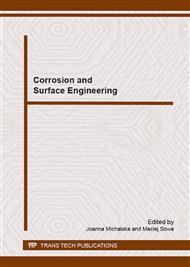p.83
p.87
p.91
p.95
p.99
p.103
p.107
p.111
p.115
Adsorption Kinetics of Benzothiazole and 2-Mercaptobenzothiazole on Microcrystalline Gold and Silver Surfaces
Abstract:
Adsorption kinetics of benzothiazole (BNS) and mercaptobenzothiazole (2-MBT) (1×10-1M, 1×10-2M and 1×10-3M) were studied during 5000 s on gold and silver coated At-cut quartz microelectrodes, using EQCM. The frequency change fits well to the Langmuir isotherm in the case of 2-MBT, while BNS presents adsorption-desorption periods making the fitting non realiable. The calculated ΔGads of 2-MBT corresponds to physisorption Ag (-1.38 kcal mol-1) and Au (-1.94 kcal mol-1). On both metal surfaces (Au and Ag) the amount of adsorbed mass for 2-MBT is significantly larger (20.76 μg cm-2 and 6.03 μg cm-2) than on BNS (0.33 μg cm-2 and 0.88 μg cm-2). These facts could be explained by the deprotonation of 2-MBT giving place to an anion, which is prone to interact with both positively charged surfaces of Au and Ag. However, BNS protonates giving place to a cation and making more difficult its adsorption on both metals.
Info:
Periodical:
Pages:
99-102
Citation:
Online since:
January 2015
Authors:
Price:
Сopyright:
© 2015 Trans Tech Publications Ltd. All Rights Reserved
Share:
Citation:


